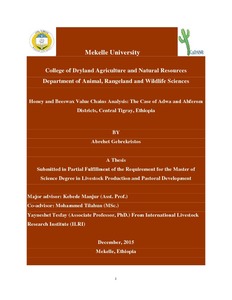Resource information
Beekeeping is an appropriate and well-accepted farming activity which directly and indirectly contributes to smallholder income generation in Adwa and Ahferom districts. But there are a number of problems in honey and beeswax value chains that can be faced from production up to consumption. This study aimed at honey and beeswax value chain analysis in Adwa and Ahferom districts with specific objectives of describing and characterizing the different value chain functions, actors and service providers; identify factors affecting honey and beeswax value chain; and determine socio economic contribution of honey and beeswax value chain. Multistage sampling technique was used to identify the sample respondents. Data were collected from multiple sources including farmers, traders, processors and service providers by using semi structured interview, key informants interview, group discussion and field observation. Data were computed to descriptive statistics, probit regression models and triangulation. In this study there are multiple actors and service providers that directly and/or indirectly involve in the honey and beeswax value chains. The major factors that influence adoption of beekeeping technologies were age, education, extension service and total land size. From the result, there was significance mean difference in annual income between beekeepers and non beekeepers (p=0.001) with better income of the beekeepers. Benefit of beekeepers from white honey is higher than Amber/golden honey. The major problems in honey and beeswax value chains along each stage were shortage of modern beekeeping equipments, lack of beekeeping skill, lack of market linkage and lack of extension support. Generally, there are different value chain actors and service providers along the value chain. Honey and beeswax value chains used as source of food, income and employment moreover, total income of beekeepers was higher than non beekeepers. Honey and beeswax value chains were found to be influenced by different household, institutional and bio-physical factors despite its substantial economic and social values. Hence, addressing these constraints will be pertinent to maximize the benefits of honey and beeswax value chain.



